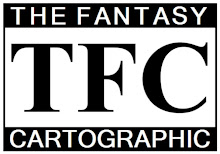So all of this looking at gaming material online really got me back into the mood. And one of the things that I loved about gaming was, as I said previously, the maps. I love ‘em! When I played D&D regularly, I drew maps all the time. I drew maps for everything, and I drew more maps than I could possibly use. Dungeons. Towns. Castles. Keeps. Binders full of graph paper maps…
So one night, after I had surveyed the latest offerings, I got bored and decided to try drawing some maps. But I wanted to see what could be done on my computer. What did I have on my computer? MS Paint. Yes, Paint. And a mouse. Now firstly, Paint is a terrible program. Come on, you’ve all doodled something with it, and you know that there really isn’t much to it. But it’s okay for simple things, and it’s, well, simple. Secondly, drawing anything with a mouse is difficult. I don’t care who you are.
But that was all I had, so I set to it: First, draw a grid—simple enough. Why? Because even on the computer I wanted my graph paper. Then messed around and drew some squiggly lines that became a cave, then a cave complex. Took that image and pasted it into a word document just to see what it would look like. Printed it out, and voila! Map on paper.
Of course, this being Paint and my first attempt, I learned that pixilation makes my nicely curvy cave complex look really not curvy at all. But it was late and time to hit the rack.
Next night, I re-did the grid to improve the resolution. I actually doubled the number of pixels per square. Then I drew another cave complex. Dropped it into a word document, and printed it out. Map number two! Less pixilated, smoother, and I liked how it looked.
Okay, so perhaps there’s not much to all that. But it got me excited about mapping on a computer. Now the maps were simple. Black and white, not artistic, per se. But they were functional. Frankly, IMO, they were as good as the maps that started it all for TSR. (Which put me easily 25 years behind the onward march of mapping technique and style.) But I liked them. So I kept on playing around, gradually improving the resolution, and learning short cuts and tricks to make MS Paint and mouse drawing quicker and more efficient.
[Now for a tangent on resolution, for those who may or may not be interested. Any good image software today will allow you to set the number of pixels per inch for your work. MS Paint does not. All it does is spit out a bitmap. The only way to really improve resolution is to take whatever image you drew and, when you insert it into a word document, or other publishing software, shrink the size of the image. Take an image that is 400 pixels wide and drop it into a document. If the image is 8 inches wide then the resolution is 50 pixels per inch (ppi). Take that same image and resize it to be only 4 inches wide, and the resolution just jumped up to 100 ppi.
(I’m not going to get into a technical discussion regarding ppi and dots-per-inch (dpi), because while close, they are not quite truly equivalent. But for the sake of my story, they may as well be.) Most published material out there that contains images or artwork of any kind uses a resolution that is at least 300dpi, and sometimes more. I didn’t really fully appreciate this until after I had drawn some maps, although it’s fairly obvious when you look at them on the printed page. None of my first set of maps would equate to 300dpi, but later ones eventually would.]
Time wore on, and I drew several maps. But I have to say: Drawing maps as I was, with MS Paint and a mouse, is a time-intensive, mind-numbing experience. I was doing it mainly to see what I could accomplish. Despite the pain of it, it was a nice little creative outlet for me. So I kept at it.
Subscribe to:
Post Comments (Atom)








No comments:
Post a Comment